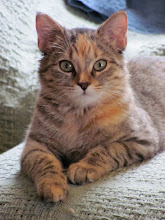
A man from the Tohono O'odham Nation.

A traditional Tohono O'odham pendant.

Paul's thinking of a new career as a fortune teller.

Me, with a really, really big crystal.
Today, Paul and I went to a big show called the Pueblo Gem and Mineral Show. It was the opening day of this particular show, so it was pretty crowded. One vendor told us however that the I-10 construction had really cut down on the opening day traffic. This show had things that I never even imagined existed. We talked to one vendor that had bathroom sinks made of large slabs of polished fossils from Morrocco. They were really beautiful. I'd love to have one for our bathroom remodel. There were giant crystals like those in the photos above, as well as 10 foot tall amethyst crystals that have been sawed in half. I don't think the airline would let me carry that on. We saw one giant smokey quartz crystal the size of a Volkswagon Beetle. The price tag was 1oo,ooo dollars. A little out of my price range. I asked the vendor what was the likelihood that it will get sold. She said that the odds were good, as last year at the same show they sold a larger one for 250,000 dollars. Wow.
At this same show, we met a really nice man who is a member of the Tohono O'odham Nation here in Southern Arizona. He was wearing a really interesting shell pendant and he was nice enough to tell me about it. In ancient times, his people would trade with coastal groups and bring back shells. They would make a resist of pitch made from pine sap which they would cook until it was thick and sticky. The resist would be painted on the shells in traditional and meaningful patterns. The one in the picture is meant to wish rain for the people. In the meantime, fruit from the saguaro cactus was harvested and made into wine, which was then left to ferment until it became acidic. The shells would then be soaked in the wine for days until the parts of the shell not protected by the pitch were etched. The time required for etching depended on how much rain fell in the desert before the harvest of the fruit. The amount of acidity in the fruit was effected by how wet the year had been. We later met the man who made the piece in the photo and he told me that this etching process was nearly lost to time, but now he a couple other artists have revived it. He will soon have a website and I will pass that on to you when he does. It's amazing the things that you learn and the people that you meet when you stop to rest your feet.

































.jpg)





















